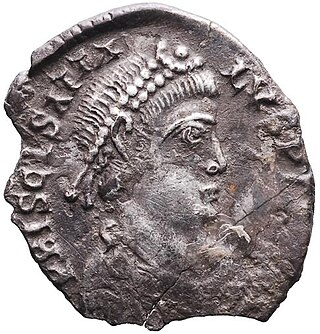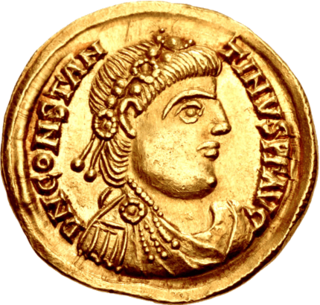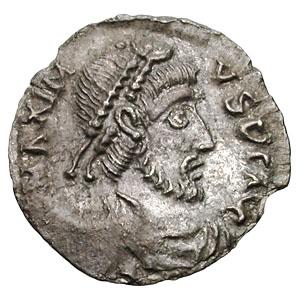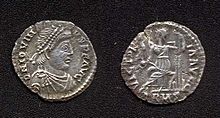
Honorius was Roman emperor from 393 to 423. He was the younger son of emperor Theodosius I and his first wife Aelia Flaccilla. After the death of Theodosius, Honorius ruled the western half of the empire while his brother Arcadius ruled the eastern half. In 410, during Honorius's reign over the Western Roman Empire, Rome was sacked for the first time in almost 800 years.
The 400s decade ran from January 1, 400, to December 31, 409.

Year 410 (CDX) was a common year starting on Saturday of the Julian calendar. At the time, it was known as the Year after the Consulship of Honorius and Theodosius. The denomination 410 for this year has been used since the early medieval period, when the Anno Domini calendar era became the prevalent method in Europe for naming years.

Year 408 (CDVIII) was a leap year starting on Wednesday of the Julian calendar. At the time, it was known as the Year of the Consulship of Bassus and Philippus. The denomination 408 for this year has been used since the early medieval period, when the Anno Domini calendar era became the prevalent method in Europe for naming years.

Year 409 (CDIX) was a common year starting on Friday of the Julian calendar. In the Roman Empire, it was known as the Year of the Consulship of Honorius and Theodosius. The denomination 409 for this year has been used since the early medieval period, when the Anno Domini calendar era became the prevalent method in Europe for naming years.

Year 412 (CDXII) was a leap year starting on Monday of the Julian calendar. At the time, it was known in Europe as the Year of the Consulship of Honorius and Theodosius. The denomination 412 for this year has been used since the early medieval period, when the Anno Domini calendar era became the prevalent method in Europe for naming years.
The 410s decade ran from January 1, 410, to December 31, 419.

Year 413 (CDXIII) was a common year starting on Wednesday of the Julian calendar. At the time, it was known as the Year of the Consulship of Herclianus and Lucius. The denomination 413 for this year has been used since the early medieval period, when the Anno Domini calendar era became the prevalent method in Europe for naming years.

Constantius III was briefly Western Roman emperor of the West in 421. He earned his position as Emperor due to his capability as a general under Honorius, achieving the rank of magister militum by 411. That same year, he suppressed the revolt of Constantine III, a Roman general who had declared himself emperor. Constantius then went on to lead campaigns against various barbarian groups in Hispania and Gaul, recovering much of both for the Western Roman Empire. Constantius married Honorius's sister Galla Placidia in 417, a sign of his ascendant status, and was proclaimed co-emperor by Honorius on 8 February 421. He reigned for seven months before dying on 2 September 421.

Constantine III was a common Roman soldier who was declared emperor in Roman Britain in 407 and established himself in Gaul. He was recognised as co-emperor of the Roman Empire from 409 until 411.

Athaulf was king of the Visigoths from 411 to 415. During his reign, he transformed the Visigothic state from a tribal kingdom to a major political power of Late Antiquity.

Jovinus was a Gallo-Roman senator and claimed to be Roman Emperor.

Constans II was caesar or heir apparent to his father Emperor Constantine III from 407 to 409 and co-emperor with Constantine and the Western Roman Emperor Honorius from 409 until his death. Constans was a monk prior to his father being acclaimed emperor by the army in Britain in early 407. Constans was summoned to the new imperial court, in Gaul, appointed to the position of Caesar and swiftly married so that a dynasty could be founded. In Hispania, Honorius's relatives rose in 408 and expelled Constantine's administration. An army under the generals Constans and Gerontius was sent to deal with this and Constantine's authority was re-established. Honorius acknowledged Constantine as co-emperor in early 409 and Constantine immediately raised Constans to the position of co-emperor, theoretically equal in rank to Honorius as well as to Constantine. Later in 409 Gerontius rebelled, proclaimed his client Maximus emperor and incited barbarian groups in Gaul to rise up. Constans was sent to quash the revolt, but was defeated and withdrew to Arles. In 410, Constans was sent to Hispania again. Gerontius had strengthened his army with barbarians and defeated Constans; the latter withdrew north and was defeated again and killed at Vienne early in 411. Gerontius then besieged Constantine in Arles.

Maximus was a Roman usurper in Hispania. He had been elected by general Gerontius, who might have been his father.
Goar was a leader of the Alans in 5th-century Gaul. Around the time that the Vandals and other Alans under Respendial crossed the Rhine in 405 or 406, Goar's band of Alans quickly joined the Romans, and subsequently played a role in the internal politics of Gaul.
Sarus or Saurus was a Gothic chieftain, known as a particularly brave and skillful warrior. He became a commander for the emperor Honorius. He was known for his hostility to the prominent Gothic brothers-in-law Alaric I and Athaulf, and was the brother of Sigeric, who ruled the Goths briefly in 415.
Edobichus was a general of the Roman usurper Constantine III. Although he was a native of Britain, according to Zosimus his ancestors were Franks.
Gerontius was a general of the Western Roman Empire, who initially supported the usurper Constantine III but later opposed him in favour of another usurper, Maximus of Hispania.

Eucherius was the son of Stilicho, the magister militum of the Western Roman Empire, and Serena, a Roman noblewoman who was the niece of Eastern Roman Emperor Theodosius I. He was born in c. 388 in Rome, Italy. Despite being the son of the magister militum, Eucherius did not rise farther than the modest rank of tribune of the notaries. Stilicho was accused by his political opponents of plotting to install Eucherius as a third emperor in Illyricum, and as a result of this Stilicho was arrested and executed on 22 August 408, and Eucherius soon after.












